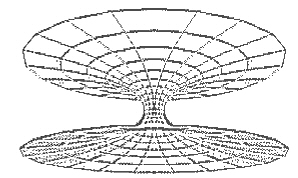THE STAR*GATES
by E. Vegh © 2006
The Sumerian Thread: As Above,
So Below
Table of Contents
You cannot teach a man anything;
you can only help him discover it in himself.
- Galileo Galilei
"The Dragon on His Throne"

A Wormhole
Consider this quote from the ancient
text entitled, "Enki and the world order":
"Grandiloquent lord of heaven
and earth, self-reliant, father Enki, engendered by a bull, begotten by
a wild bull, cherished by Enlil the Great Mountain, beloved by holy An,
king, mec tree planted in the Abzu, rising over all lands; great dragon
who stands in Eridug, whose shadow covers heaven and earth, a grove of
vines extending over the Land, Enki, lord of plenty of the Anuna gods,
Nudimmud, mighty one of the E-kur, strong one of heaven and earth! Your
great house is founded in the Abzu, the great mooring-post of heaven and
earth" [1]

The mec tree planted in the ABZU.
A grove of vines rising over all the lands. The great mooring-post of heaven
and earth. Obviously, this is not referring to a simple ziggurat, and isn't
it amazing that it also embodies "As above, so below?"
Notice how, in this particular tale,
Enki is referred to as the "great dragon?" Was he literally a dragon? Perhaps,
in a manner of speaking, he was. But remember, later, Tiamat would also
be called a "dragon," who connected a place in the "Field" constellation
[1a],
to planet Earth. Since Tiamat was part of the "star gate" system at Enki's
E.ABZU, of which he claimed ownership, it seems likely that he was simply
being referred to, in a dramatic way, as the owner of said property. Afterall,
he wasn't literally a wild bull or begotten by a wild bull and yet, that's
exactly what's indicated in the texts. Rather, he was called the Great
Star Gate, the Great Tiamat, the Great Wormhole, the Great Dragon, symbolically,
as its owner and operator. Of course, he may have also been from a race
of extra-terrestrial beings who appeared rather "Reptilian".
It might be pertinent to mention
here that a specific group of angels, in the biblical texts, called "Seraphim,"
were serpent-like in appearance. Several authors have noted textual similarities
between Enki and the biblical Satan, the "Serpent" or "Seraph" in the Garden
of Eden. So it is possible the reference to Enki being the "great dragon,"
may have more than one application. For example, It's no small coincedence
that Enki as the biblical Satan is, in this metaphor, a "dragon" or "serpent"
in the "tree."
Also consider that the great dragon
"stands" in Eridu(g) like the "mec tree," which is likely a reference to
the wormhole with all its "branches", a grove of vines rising over the
lands and also buried in the earth beneath the E.ABZU, like the root system
of a huge tree.
For example, reconsider the opening
image on this page:

A Wormhole
How similar it looks to a tree with
its branches spreading across the heavens and roots digging into the earth.
Still skeptical? Don't believe in
the scientific possibility of wormholes? Allow me to provide evidence for
your consideration:
Wormholes or white holes, are shortcuts,
connecting distant points in space-time. Mechanically, they appear as double-ended,
whirling vortexes, flared at each end and embody the hourglass shape:

Over the last few decades, there
has been quite a bit of debate over whether such a wormhole is physically
possible. The amount of energy to sustain it, physicists argued, would
be too immense and the passageway would collapse on itself in micro-seconds.
However, in the last 5 years, the original arguments have been met with
new findings, such as this one, reported in BBC News on April 12, 2000:
According to Sergei Krasnikov
of the Pulkovo Observatory in St Petersburg, the new wormhole can create
its own abundant supply of exotic matter. This way, the wormhole would
be big enough and could stay open long enough for people to use.[2]
"What's new is that this wormhole
actually generates enough to make it arbitrarily large," says Krasnikov
who works at the Laboratory of Stellar Physics.
In 2005, a new argument arose against
practical wormhole usage, but was immediately contested:
Calculations by the Oregon
researchers show a wormhole that combines exotic matter with semi-classical
space-time would be fundamentally unstable.
"We aren't saying you can't
build a wormhole. But the ones you would like to build - the predictable
ones where you can say Mr Spock will land in New York at 2pm on this day
- those look like they will fall apart," Dr Hsu said. [...]
However, there is still support for
the idea of traversable wormholes in the scientific community. One physicist
told BBC News there could be problems with Hsu's and Buniy's conclusions.
[...]
"Violations of the null energy condition
are known to occur in a number of situations. And their argument would
prohibit any violation of it," the scientist commented. [...]
The underlying physics of wormholes
was not in doubt, the researcher argued. The real challenge was in explaining
how to engineer wormholes big enough to be of practical use.
[3]
So, theoretically, the traveller enters
one end of the vortex and emerges on the other end. Another way to represent
it is like this:

Notice how it's flared at both ends
and thinner in the middle, which is called the "throat" of the wormhole
(the throat or neck of Tiamat is usually depicted much shorter in length,
but represents the distance between one point and another, or rather, between
one star gate and another). Turned on end, it takes on the characteristic
shape of the hourglass, the "As above, so below" symbollism, and the mec
tree of the great dragon.
Marduk of babylonian fame, invited
the gods to visit him in Babylon, his "Gate of the Gods," as they employed
the gates between earth and heaven. It is believed he was partially quoting
earlier stories about the ante-diluvian gods, as he had also absorbed their
tales and activities, claiming them to be his own exploits. It is also
believed, per the biblical accounts of the flood, the Tower of Babel, and
the bottomless pit of Revelation 9, that the star gate or bottomless pit
entrance at Eridu has been buried for thousands of years. If it has been
dug up since then, it isn't likely that the general public would be made
aware of it.
All these ante-diluvian symbols of
Anunnaki technology, became religious icons, religious buildings and religious
symbols following the flood. The mec tree or wormhole of the great dragon
became the sacred tree on the temple grounds of mesopotamian temples. In
essence, the Tree containing the Serpent in the Garden, had been immortalized
on the sacred grounds of the temples of Akkadia and Babylon without the
people ever fully realizing its meaning. The ABZU or star gate, became
the primeval waters symbollized in the sacred pools or sacred water receptacles
for ritual bathing in temples in the near and middle east. Enki's floating,
speaking and flying palace, called the E.ABZU, became the model for ziggurats,
pyramids and earthly thrones of power. And the hourglass shape, which defined
the shape of the dragon, the wormhole and Tiamat, became a symbol for the
power of the holy mountain, the power of the ziggurat and pyramid.
However, of special note is the hourglass
symbollism represented by "Mt. Sumeru" or "Mt. Meru," of ancient hindu
and buddhist history, which is depicted as a mountain formed in an hourglass
shape. According to the mythology surrounding it, Mt. Sumeru has its roots
in hell and its upper reaches in heaven. Upon the death of Buddha, it is
said that Mt. Sumeru was broken in two at the intersection between the
two triangles of the hourglass, breeching the connection between its upper,
heavenly levels (the upper, downward pointing triangle) and the earthly
levels (the lower, upward pointing triangle). In effect, the wormhole had
been severed at the throat, the dragon Tiamat had been slain, cut off at
the neck or cut in half (an event further elaborated on in the Enuma Elish),
the bottomless pit had been rendered useless and buried.
Enki's "star gate", however, was
not the only one. In fact, his sumerian brother, "Enlil," also appears
to have had his own "Abzu", which is the subject of the next page!
*(Note: For further clarification
on this topic, read The
Enuma Elish and the free e-book, The
Anunnaki and the Abyss.
Footnotes
1 Enki
and the world order, Black, J.A., Cunningham, G., Ebeling, J., Flückiger-Hawker,
E., Robson, E., Taylor, J., and Zólyomi, G., The Electronic Text
Corpus of Sumerian Literature (http://etcsl.orinst.ox.ac.uk/), Oxford 1998-
. The Electronic Text Corpus of Sumerian Literature
1a Enki
and the world order, Black, J.A., Cunningham, G., Ebeling, J., Flückiger-Hawker,
E., Robson, E., Taylor, J., and Zólyomi, G., The Electronic Text
Corpus of Sumerian Literature (http://etcsl.orinst.ox.ac.uk/), Oxford 1998-
. The Electronic Text Corpus of Sumerian Literature2 "Wormholes
take on a new dimension", BBC News, April 12th, 2000.
3 Paul Rincon,"Wormhole
'no use' for time travel", BBC News, May 23rd, 2005.
<-Back -2- Next->
|

